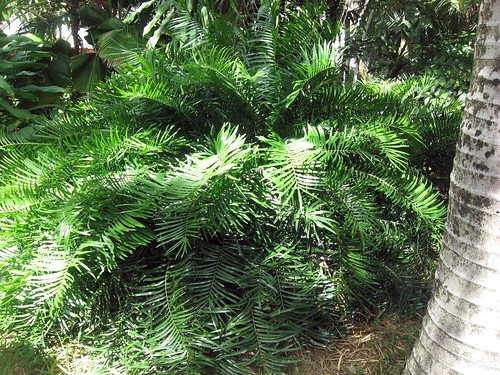Edited on 5/1/09 - correcting the identification and adding and further info.
Another bit of dino-salad.
(I'm fairly sure) this is Zamia somethingorother, looking a lot like a Florida coontie or a close relative thereof. As you may have guessed from the previous sentence the taxonomy on these is a bit complicated. There are a lot of different forms and the differences are complicated because instead of forming trunks these chaps form undergroud rhizomes which means a) Cycad ground cover baby(!) and b) vegetative propagation of a number of distinct forms which may or may not be morphs, subspecies or species. I've heard the names Zamia integrifolia, Z. pumila and Z. floridiana all used and have no clue which is right. This awesome article by cycad legend Tom Broome will tell you more.
Another bit of dino-salad.
(I'm fairly sure) this is Zamia somethingorother, looking a lot like a Florida coontie or a close relative thereof. As you may have guessed from the previous sentence the taxonomy on these is a bit complicated. There are a lot of different forms and the differences are complicated because instead of forming trunks these chaps form undergroud rhizomes which means a) Cycad ground cover baby(!) and b) vegetative propagation of a number of distinct forms which may or may not be morphs, subspecies or species. I've heard the names Zamia integrifolia, Z. pumila and Z. floridiana all used and have no clue which is right. This awesome article by cycad legend Tom Broome will tell you more.
What I can tell you is this is one of my favourites just because its so different. The cones and seed heads look brilliant emerging from various points on the rhizome too. I can also tell you I'm exceptionally jealous of Florida Cracker because from the look of his blog Pure Florida HQ is loaded with them. In fact Pure Florida has everything you need to know about Coontie Cultivation. What's well worth noting about Florida Cracker's Coontie Baron plan is that this is yet another example of a plant with a long prehistorical lineage coming back into its own in modern urban planting just like Metasequoia and Ginkgo.
Update: The true coontie is currently called Z. integrifolia (potential remains for some splitting). This plant is, I believe, in fact Zamia pumila. Z. pumila is effectively the Caribbean version of Z. integrifolia picking up in the north Caribbean where the coontie leaves off and was the first species of Zamia recognised. More on both species to follow in '09.
This is one of a number of cycads that are unlabelled in a collection near to me and as such the identification is a best guess based on my own and others' assessment of the plant and the photo's above and so may be best treated with a pinch of salt.
Update: The true coontie is currently called Z. integrifolia (potential remains for some splitting). This plant is, I believe, in fact Zamia pumila. Z. pumila is effectively the Caribbean version of Z. integrifolia picking up in the north Caribbean where the coontie leaves off and was the first species of Zamia recognised. More on both species to follow in '09.
This is one of a number of cycads that are unlabelled in a collection near to me and as such the identification is a best guess based on my own and others' assessment of the plant and the photo's above and so may be best treated with a pinch of salt.

3 comments:
I love coonties. I am in charge of the Palm and Cycad walk at my local Botanical Garden. I will have some pictures in my next post as a matter of fact. We just cleaned out a big section of overgrown ferns that were taking over the Coonties. Great blog I will check back often.
Thanks LP - I've been checking out your blog and its twin since I saw them referenced at A Bigger Pot.
I was rather jealous of the big Dioon cycads you get to play with and show off.
I want one. But I guess I need a heated greenhouse first.
Post a Comment